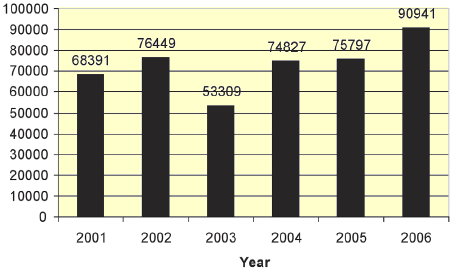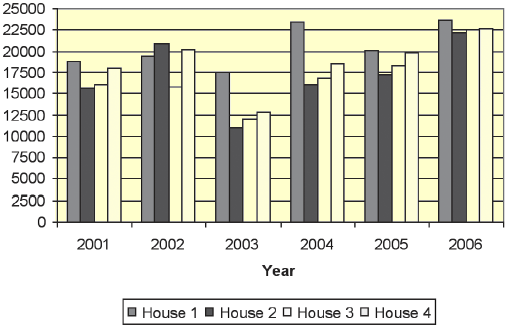



Applied Broiler Research Farm Report: Electricity Usage Before and After Renovation
By G. Tom Tabler, Manager, Applied Broiler Research Unit - Savoy Center of Excellence for Poultry Science University of Arkansas and published in Avian Advice Newsletter Summer 2007 Volume 9 No. 2.Introduction
 |
The Applied Broiler Research Farm (ABRF) is a 4-house commercial scale broiler farm owned by the University of Arkansas with research capabilities that include the close monitoring of total electricity usage and the individual electricity usage of each house. The farm was constructed in 1990 and completely renovated in early 2006, with resumption of growing broilers in April 2006. This is the second of a planned series of “before and after” reports on ABRF performance in various areas.
Electricity Usage
The ABRF has electric meters on each broiler house that allows electricity usage to be closely monitored on the farm. Electric meters are read weekly and usage has been calculated for each of the 92 flocks of broilers raised on the farm since 1990. As expected, electricity usage is always much greater in the summer when tunnel fans and cool cells are running much of the time as opposed to the winter season when minimum ventilation is used. Total electricity usage by flock for the period 2001-2006 is listed in Table 1. During the period 2001-2004, the farm raised 6 flocks of broilers per year. In general, flocks were placed in the months of January, March, May, July, September, and November. There were no flocks placed in November 2005, January 2006, or March 2006 because the farm was shut down for renovations.
Electricity usage increased for each flock in 2006 compared to the average of the previous 5 years. This was expected because there is no longer natural ventilation available since curtains were replaced by solid sidewalls on all 4 houses. Mechanical ventilation (either sidewall or tunnel fans) is now the only method of air exchange. In addition, there is also no natural light available after renovations. All lighting is now with artificial light (light bulbs), which requires additional electricity, compared to the period before renovations when natural lighting available during the day. We are currently investigating the use of cold cathode lighting in one house which may have the potential for substantial energy savings over more typical incandescent lighting and, unlike fluorescent lighting; cold cathode bulbs are easily dimmable. These efforts will be reported at a later date.
| Table 1. Electricity usage (kilowatt hours) at the Applied Broiler Research Farm (2001-6) | ||||||||
| Flock | Placement Month | 2001 | 2002 | 2003 | 2004 | 2005 | 5-Year Avg. | 2006 |
| 1 | January | 10920 | 9757 | 8672 | 6853 | 12640 | 9768 | -- |
| 2 | March | 7258 | 9423 | 7570 | 6625 | 10729 | 8321 | -- |
| 3 | May | 15341 | 9835 | 9900 | 13561 | 14283 | 12584 | 16070 |
| 4 | July | 23806 | 20709 | 14810 | 17042 | 19681 | 19210 | 23607 |
| 5 | September | 4326 | 18092 | 4683 | 17139 | 18464 | 12541 | 28964 |
| 6 | November | 6740 | 8633 | 7674 | 13607 | -- | 9164 | 22300 |
Even though electricity usage has increased versus before renovations, that may not be as bad as it sounds. While the solid sidewalls have increased electricity usage, if those same solid sidewalls can save enough fuel (propane), the farm is better off in the long run. When the farm was built, electricity costs were roughly $0.05 per kilowatt hour and propane cost $0.52 cents per gallon. Electricity costs are now roughly $0.06 per kilowatt hour while propane costs are roughly $1.35 to 1.50 per gallon. As you can see, electricity costs are roughly the same now as when the farm was originally built in 1990, but, propane costs have roughly tripled. Therefore, the farm can afford to use several extra kilowatt hours of electricity and still be ahead if it can save on propane use.
Kilowatt hours: Total and by individual house
Figure 1 illustrates the total kilowatt hours used on the farm from 2001 through 2006. During the 6 flocks per year in 2001 through 2004 and 5 flocks in 2005 before renovations, the farm had never used more than 76,500 kilowatt hours in a single year. However, in 2006, during which time only 4 flocks were grown after renovations were complete; the farm used almost 91,000 kilowatt hours. This figure will be considerable higher in the future when a full year’s worth of production is calculated vs. the 8 months worth of production shown here. Again however, it may be possible to compensate for this greater kilowatt hour usage with increased fuel savings. This is something we will continue to investigate.

Figure 1. Total kilowatt hours of electricty used (by year) at the Applied Broiler Research Farm (2001-6).
Figure 2 indicates the kilowatt hour usage by individual house for the period 2001 to 2006. During most years, house 1 used the most kilowatt hours. This was due (among other things) to the stir fans and jet tubes were used to distribute hot air off the ceiling back down toward the floor during winter periods. Also, an experimental litter burning furnace was installed at that house which used additional electricity that could not be separated from house electricity. After renovations, and during 2006, electricity usage was similar for houses 2, 3, and 4. Usage was somewhat higher in house 1 due, in part, to the experimental litter burning furnace.
Aside from the experimental furnace at house 1, renovations have made all 4 houses quite similar in design and (as illustrated by Figure 2) houses were similar electricity usage during 2006, especially in houses 2, 3, and 4. Again, only a partial year (8 months) is included in the 2006 data. In the future, more data collection will provide a better understanding of actual yearly usage.

Figure 2. Electricity usage by house at the ABRF (2001-6).
Summary
Electricity usage was higher after the renovations than before. This was expected and is due, in part, to solid sidewall construction, loss of natural daylight as a light source, and an increase in mechanical ventilation throughout the year. However, if the solid sidewall construction and an overall tighter house save enough on the fuel bill, the increase in electricity usage will be more than offset by increased fuel savings because propane is much more expensive than electricity at the present time. Data collection will continue on both propane and electricity usage and will be disseminated to provide producers a better “before and after” assessment of the value of renovations at the ABRF.











